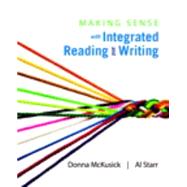0134023889 / 9780134023885 Making Sense with Integrated Reading and Writing Plus MySkillsLab with Pearson eText -- Access Card Package
Package consists of:
- 0133995151 / 9780133995152 MySkillsLab with Pearson eText -- Inside Star Sticker
- 0133995178 / 9780133995176 MySkillsLab with Pearson eText -- Glue in Access Card
- 0134001117 / 9780134001111 Making Sense with Integrated Reading and Writing
For advanced courses in Integrated Reading and Writing.
Helps students become powerful, insightful writers and readers
Making Sense with Integrated Reading and Writing takes a comprehensive approach to English mastery, combining both reading and writing instruction into one seamless resource. The text is relevant and engaging, empowering students to recognize and learn from the inherent connection between reading critically and writing well.
The approach of Making Sense is based on the premise that language is used to construct knowledge and to interact with others. This approach proposes that both readers and writers must organize thoughts, infer and construct ideas, and revise meaning recursively in both the processes of reading and writing.
The authors explore these ideas through challenging, authentic readings that inspire students to reach new levels of understanding, and by encouraging students to ask hard and unique questions (How do I learn? Why do I think this way?) Comprehension questions that follow the readings guide students through basic understanding to inference and analysis; these written responses often become the basis for longer and more challenging writing assignments.
Also Available with MySkillsLab ®
This title is also available with MySkillsLab — an online homework, tutorial, and assessment program designed to work with this text to engage students and improve results. Within its structured environment, students practice what they learn, test their understanding, and pursue a personalized study plan that helps them better absorb course material and understand difficult concepts.









